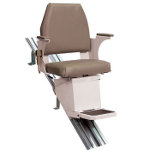Understanding Stair Lifts and their Uses
Published by Stephen on July 17, 2009 Under stair lifts When younger, getting to the top of the staircase is seldom seen as a major problem, nor is it done with difficulty. However, with age, climbing up and down the stairs can become much harder, often as the result of health conditions, such as arthritis or reduced vision. Having difficulty using the stairs is very common among seniors and staircase falls are the most common reason for hospitalization, as well as the most common cause of accidental death. As a result of the very serious danger that is presented by the staircase, many seniors use stair lifts in their home.
When younger, getting to the top of the staircase is seldom seen as a major problem, nor is it done with difficulty. However, with age, climbing up and down the stairs can become much harder, often as the result of health conditions, such as arthritis or reduced vision. Having difficulty using the stairs is very common among seniors and staircase falls are the most common reason for hospitalization, as well as the most common cause of accidental death. As a result of the very serious danger that is presented by the staircase, many seniors use stair lifts in their home.
What are Stair Lifts?
Stair lifts are special tools that enable a senior, or other person who has limited mobility, safely use the stairs. These safety tools are designed to actually carry the senior up the stairs, so there is little risk of a fall or other staircase injury. Typically, stair lifts utilize a simple plastic chair to move its occupant up the staircase, which is why it is not uncommon to hear them referred to as stair chairs. However, this is not always the case. Some use much more luxurious chairs and there are even standing stair lifts available, which are called perch lifts.
Standing stair lifts, or perch lifts, can be very valuable to those recovering from knee or hip replacement surgery who can not bend their knees enough to safely sit down. However, for those that do not have a medical reason to use a perch lift, it is usually better to go with a standard stair chair, which is much safer.
Stair Lifts vs Elevators
Stair lifts are designed to safely move its occupant up the staircase, while offering a cost effective alternative to installing a residential elevator. Elevators can be very practical and extremely useful, however they are very costly to install. This is because the home must be modified to include the elevator shaft and then the elevator must be installed, both of which are very costly, can take a good deal of time, and does not even take into account the cost of the elevator itself. Most stair lifts, on the other hand, can be installed with almost no modification to the home, aside from drilling some holes in the staircase.
Installing a Stair Lift
Some stair lifts, like those offered by AmeriGlide, are designed to be installed by the homeowner, which helps reduce installation costs. These types of stair lifts feature a simple track and chair design, with the track secured to the staircase and the chair moving slowly along the track.
For curved staircases, however, it is usually not possible to do the installation without professional help. As such, a curved stair lift is very expensive, so much so that in some cases a residential elevator becomes an acceptable alternative to a curved stair lift. This is as a result of the exurbanite cost of a curved stair lift, as well as the time it takes for it to be built and installed. When compared to an elevator, the cost is not that much less and an elevator actually holds its value, increasing the homes value and adding an incentive for buyers. Curved stair lifts, on the other hand, have a very reduced resale value, because they can only be used on homes that have an identical staircase.
To help prevent falls, a stair lift can be a powerful safety tool, which allows full access to a home and ensure that the individual can safely use the stairs unassisted.
No Comments |
Add a Comment